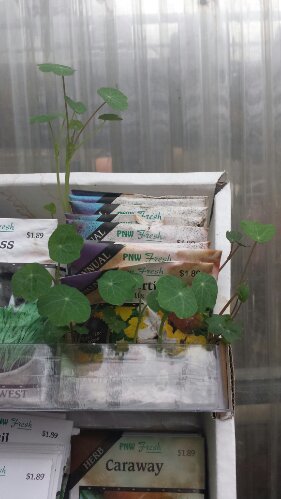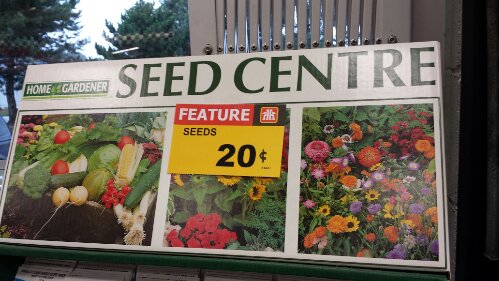I was invited by the YMCA Connections and Immigrant Services to do a garden presentation/demonstration at the Farm, Food and Garden Event. My presentation/demonstration was on Kitchen Scrap Gardening -Don’t throw it, Grow it! however I thought this was an excellent opportunity to give some of my seeds away.
Here are the planting instructions for the seeds I gave away:
Chive Seeds:

Chives are an easy care, cool-season, cold-tolerant perennial that can be planted in early spring.
Growing chives right outside your kitchen door in containers and window boxes is really the best way to grow them.
They will grow in full sun or partial shade and once established, mature chive plants need minimal care.
- Choose a 6-8″ (15-20cm) pot
- Fill pot 1 inch from top with moist potting soil
- Sprinkle chive seeds on top of the soil
- Cover seeds with a thin layer of soil.
- Keep soil moist until grass like seedlings appear.
- Water young plants throughout the growing season.
- Plants will eventually grow to be 12 to 24 inches tall and may spread a foot across.
- The purple flowers are edible however even if you don’t eat them you may want to remove them or they will spread their seeds everywhere.
- Harvest Chives by snipping the leaves off 2″ (5cm) above the base of the plant. New leaves will sprout to fill in the gap.
Chive Butter is a great way to preserve chives. Mix 2-3 Tbs of finely chopped chives into 1/2cup (1 stick) of softened butter. Use on baked potatoes or toasted bagels.
Chive Vinegar can be made by steeping whole chive leaves in your favorite vinegar. Chive vinegar is a natural for salad dressings and vinaigrette.
Note: When it starts getting cold in the fall, you can bring the entire pot indoors, and set in a sunny window to keep a supply of chives growing through the winter. Just be sure there are no bug hitchhikers before bringing inside.
Bell Pepper Seeds:

Growing bell peppers is most commonly done in a garden bed. They grow very well next to tomatoes provided they are allowed enough space and sunlight. However, you can grow bell peppers in containers as long as they are big enough.
- Plant two or three seeds per 4 inch pot filled with potting mix indoors. Keep the soil moist until seeds germinate. Once they sprout thin the seedlings to leave the strongest plant per pot.
- Once seedling gets its 2nd set of leaves you can transplant into larger containers. Don’t set out your pepper transplants outside until night temperatures average around 13-16 degrees Celsius. (55-60 degrees Fahrenheit)
- Choose a 2-gallon or larger container that is 14 to 16 inches deep. Make sure the container has drainage holes or drill 4-5 evenly spaced holes around the bottom of the container if necessary. Then use either coffee filters or some type of screen to cover the holes.
- Fill the container with a mixture of two-thirds potting soil and one-third compost. Water the soil to dampen and allow it to drain.
- Plant one pepper plants per container, digging a deep enough hole to hold the root ball. Tamp soil down around the plant.
- Staking peppers will be necessary as the plants begin to take off. They can grow as high as 3 or 4 feet, so you need to give them some support. Place one stake in each container closely to the stem. If need be, loosely tie a bit of twine to the stake and the other end to the stem to keep it from bending over. Tomato cages will also work.
- Place the container in a sunny location, providing 6 to 8 hours of sunlight daily. Turn the pot daily, if needed to keep the plant growing upright.
- After the first fruit starts to grow, apply an amount of fertilizer along the sides of the plants. You can also let old coffee ground steep in water for a period and pour that directly on the plants. Crushed eggshells added to the soil will also help avoid blossom end rot.
- Check the soil daily for moisture and water the bell pepper plants as needed. If possible avoid wetting the foliage or letting pot stand in water. Peppers hate wet feet!
Tip-If you are a smoker wash your hands thoroughly after handling any type of tobacco product and avoid using tobacco near plants. Bell peppers like tomatoes are susceptible to tobacco mosaic virus. Symptoms include yellow or mottled leaves and stunted growth.
Sugar Pie Pumpkin Seeds

An heirloom pumpkin, these Sugar Pie Pumpkin Seeds will grow a classic eating pumpkin that is especially good for pies and canning. Vines develop small slightly ribbed, bright-orange pumpkins that are 6″-9″ in diameter and have the sweetest flavor and finest texture for pies and casseroles. These are not grown in containers and should be planted in the ground.
Here’s how to do it:
- Direct sow or transplant in late May or early June when soil warms up. Optimal soil temperature for germination is 25-35°C (68-95°F) or you can start seeds indoors during the first week of May.
- Choose a sunny spot with fertile, well-draining soil and then dig in a generous quantity of finished compost and/or composted manure. Pumpkins are big greedy feeders. The secret to growing good tasting pumpkins is lots of POOP! Pile up manure into “pumpkin hills” about the size of a small pitcher mound and then sow the seeds 2cm (1″) deep. Sow 3 seeds in each hill. Seeds should sprout in 7-14 days. If you started your seeds indoors be sure to harden off plants before transplanting your seedlings into your pile of aged manure.
- Pumpkins are 90% water so keep pumpkin plants well-watered, particularly in hot weather. Always water the soil, and avoid getting the leaves wet as much as possible because powdery mildew is almost always a problem here in the Pacific Northwest, especially when it comes to pumpkins. There are some mildew resistant pumpkin varieties out there but the sad truth is that they still get powdery mildew. It just seems to happen a little later in the season than the non-resistant varieties. The pumpkins themselves will still turn out great even if the leaves are covered in powdery mildew so I don’t worry too much about it.
- Pumpkins are mature when they have colored up well and their stems are crisp (about 110 days after transplant). For the best sugar content, cut the stem about 4cm (2″) or so from the body of the fruit. If the weather is dry, allow the pumpkins to cure in the field for 10 days, or in a warm room for 4-5 days.
What else can I say other than……..
Welcome to the Pacific North West, one of the best gardening places in Canada!

PS-For those of you who feel like you missed out on some free seeds, don’t worry!
I’ll be doing several more seed giveaways with a variety of other seeds on my Guerilla Garden Facebook Page
so be sure and follow me!

















